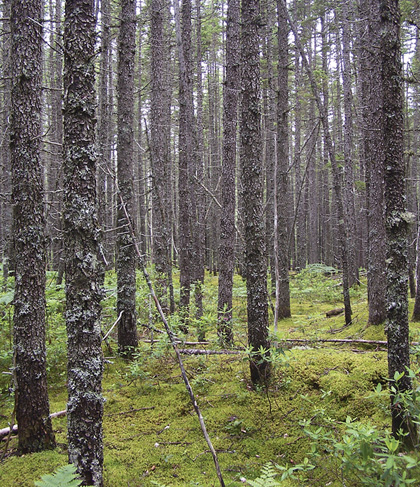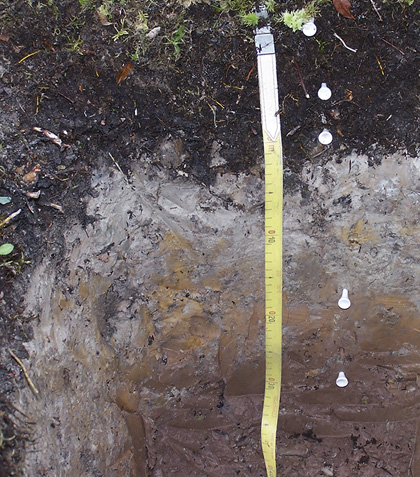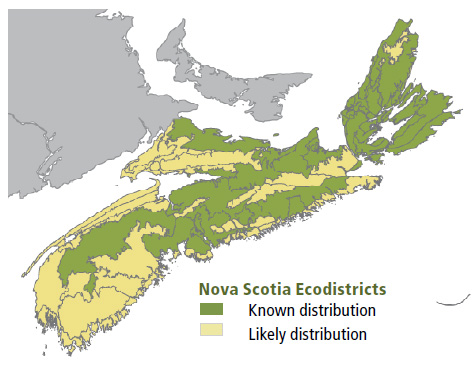
Forest Vegetation types - SP7
SP7 —Black spruce / False holly / Ladies' tresses sphagnum
Picea mariana / Nemopanthus mucronata / Sphagnum capillifolium
 |
Black Lake, Cumberland County |
Concept: This edaphic Vegetation Type (VT) has abundant black spruce and a well-developed woody shrub layer. Trees often have a hybridized appearance with traits of both black and red spruce expressed. Black spruce / False holly / Ladies' tresses occupies moister site conditions between drier upland spruce-pine types (SP1, SP2, SP3, SP4, SP5) and wet black spruce types (WC1, WC2, WC3, WC4).
Vegetation: Black spruce is the dominant overstory tree along with tamarack, red maple and balsam fir. Hybrid (red/black) spruce occurs on sites with slightly higher fertility. The shrub layer is occupied by ericaceous species such as lambkill, velvet-leaf blueberry and lowbush blueberry, along with false holly and wild raisin. A variety of herb species are possible, but the dominant plants are bunchberry, bracken and goldthread. Scattered sedges, creeping snowberry and cinnamon fern indicate the presence of increased moisture; while bracken, lady slipper and mayflower indicate low nutrient status. Bryophyte cover is dominated by Schreber's moss, wavy dicranum and stair-step moss. Pockets of sphagnum moss indicate elevated moisture levels.
Environmental Setting: SP7 is found throughout Nova Scotia on a variety of moist, nutrient poor soil types. Thick, ericaceous duff layers are common, limiting tree regeneration by seed unless disturbance creates more exposed micro-sites. Without disturbance, black spruce regeneration is usually by vegetative layering. Sites supporting this VT tend to have minimal mounding due to the shallow rooted nature of the overstory spruce. This VT is widespread and common across the Maritime Provinces.
Successional Dynamics: Moist, nutrient poor soils associated with this VT lead to an edaphic climax community dominated by black spruce. This generally even-aged VT follows stand-replacing disturbances such as fire, windthrow and harvesting. Due to its unique ecological setting, this VT does not shift to other vegetation types after disturbance, but does change in development stage. Under less frequent disturbance events, natural senescence can create some unevenness in both age class and stand structure.
Ecological Features: This forest occurs as large-patch and sometimes matrix in many parts of the province. It can exhibit closed or open canopies, depending on past disturbances and the degree of surface stoniness, which is often excessive in this ecosystem. Black spruce has intermediate shade tolerance and does not seed well under closed canopies. Vegetative regeneration by layering is common especially where there is a thick duff layer. Spruce grouse eat conifer needles in winter and may be found in this habitat. This forest may provide habitat for wetland associated species such as olive-sided flycatchers, mourning warblers, star-nosed moles and four-toed salamanders. Dwarf mistletoe sometimes creates dense witches brooms that may provide nest and rest areas for small mammals. Mature forests develop abundant old man's beard, lichen that provides important nest and forage material for some species.
 |
| Imperfectly drained soil |
Distinguishing Features: A mixedwood forest usually dominated by black spruce with a significant component of red maple and scattered other species. The shrub and herb layer is indicative of poor and dry to fresh conditions represented by lambkill and bracken. Moss cover is reduced as red maple cover increases.
| Slope Position: | Level6 Middle2 Lower1 Upper1 |
Surface Stoniness: |
(Non - Slightly)8 (Very - Excessively)1 (Moderately)1 |
Bedrock Outcrop: |
(Non-rocky)9 Slightly - Moderately)1 |
Elevation Range: |
12 - 407m |
Slope Gradient: |
Level7 Gentle3 |
Aspect: |
North1 East2 South1 None6 |
Exposure: |
Moderate8 Mod. exposed1 Exposed1 |
Microtopography: |
Slightly4 Level3 Moderately2 Strongly1 |
Drainage: |
Imperfect9 Poor1 |
Soil Type: |
ST65 ST33 ST161 Other1 |
Parent Material: |
Glacial till8 Till/Bedrock1 Glaciofluvial1 |
Rooting Depth (cm): |
(<30)8 (30-45)1 (>45)1 |
Duff Thickness (cm): |
(6-10)3 (11-20)5 (21+)1 nd1 |

